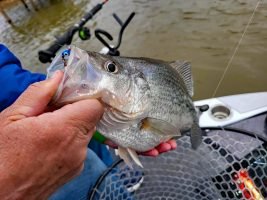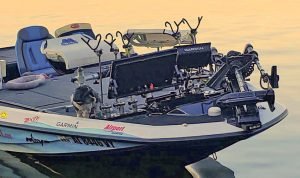Dan Dannenmueller says that stealth is often the key to catching crappie
that are exposed to heavy fishing pressure. (Photo: Brent Frazee)
Spider Scoping for Wary Crappie
by Brent Frazee
Dan Dannenmueller (a.k.a. Crappie Dan), is the publisher of CrappieNOW Magazine as well a longtime professional tournament fisherman. He is convinced that largely because of forward-facing sonar (FFS), crappie are getting harder to fool.
He believes in situations where schools of fish are exposed to heavy fishing pressure from anglers using FFS, the fish are becoming more sensitive to signs of danger.
“I really think they can feel that signal,” Dannenmueller said. “They also have become hyper sensitive to sounds. When they hear a trolling motor or maybe something dropped in the boat, they’re going to startle.”

Dannenmueller, who lives in Wetumpka, Ala., says he has seen that theory at work. On a recent fishing trip, he noticed that the crappie were particularly skittish. So, he performed an impromptu experiment.
While watching a school of crappie on his own forward-facing sonar, he dragged his heel across the carpeted deck of his fiberglass boat. The fish immediately scattered.
Then he closed the cover of his bait cooler resting on the bottom of the boat. Again, the school of crappie scattered and moved away from the boat.
Several other subtle noises got similar results. Each time, the crappie didn’t move far, and the schools would reunite after the fish scattered. But for Dannenmueller, it proved what he long suspected – namely, the importance of stealth when fishing for pressured crappie.
Granted, he said there are still some situations where the fish are easy. Spot them on FFS, drop a bait down in front of them, reel them in. But there are an increasing number of times when the fish are super sensitive.
That means experienced crappie fishermen have to come up with new ways to fool those fish.
Dannenmueller does that by combining old-school with new-school. The old-school part is spider rigging, in which fishermen slowly troll baits at a desired depth from the bow of the boat. The new-school part consists of using FFS to see schools of fish of in the distance before the boat has even disturbed the fish.
Dannenmueller calls it Spider-Scoping, and he credits that technique with putting limits of big crappie in the boat on days when the fish wouldn’t respond to other methods.
“Once I spot those schools of fish, I will kill the trolling motor and just ease up on them,” Dannenmueller said. “I’ll be 22 to 25 feet away, so I’m not going to spook them.
“With the long rods we use for spider rigging, I can push those baits into those schools before they even know I’m there.”
Dannenmueller prefers 14-foot long B’n’M Pro Staff Trolling Rods and small fly reels made by the same company. He prefers Yama 10-pound copolymer line in a high-visibility green.

He often utilizes a small Thundermist three-way T-Turn rig to present both a small jig and a minnow at the same time. He ties his main line to the top opening, then uses a pre-tied Blakemore snelled hook and a minnow on the side opening. On the bottom opening, he will have a leader with a heavy egg sinker attached about half-way down and then a small Bobby Garland plastic bait below that.
The type and size of the bait will differ according to the mood of the crappie. Dannenmueller has found success lately on 1/32nd-ounce Bobby Garland Itty Bitt baits. The recently released Mayfly has been particularly good, he said.
That’s not the only way Dannenmueller combines FFS with other techniques to catch skittish crappie, however. He also uses FFS sonar to troll with planer boards through schools of fish. He angles his transducer off to one side of the boat and goes on the prowl for schools of crappie.
“When you’re trolling, those fish will either run straight in front of you or off to the side of the boat,” he said. “I’ve seen on forward-facing sonar how they will react.
“They don’t just leave. They move out a way, but they’re still in the same general area,” he said. “That will help me determine how far out to put my planer boards.”
That technique has paid big dividends for Dannenmueller. In a tournament last year at Sardis Lake in Mississippi, he located three big schools of crappie. He spent the day trolling through those schools and ended up catching a limit of fish.
The FFS-planer-board trolling method is most effective in pre-spawn when the fish are roaming open water and again in post-spawn when they are chasing shad on the flats.
Both methods are new wrinkles on old techniques, and they can produce impressive catches in the toughest conditions.
“That’s the fun of crappie fishing,” said Dannenmueller. “Coming up with new ways to catch them. Of course, there’s no sure-fire method that will catch them every time. But if you come up with new ways to get them, you just increase your options.”
Watch more on Spider-Scoping from Crappie Dan here:
Brent Frazee has been writing about the outdoors for nearly 50 years. He spent 36 years as the outdoors editor for The Kansas City Star before retiring in 2016. He continues to write for magazines, newspapers and websites. He lives on a private lake in a Kansas City suburb, and is out chasing crappie and bass several times a week.


